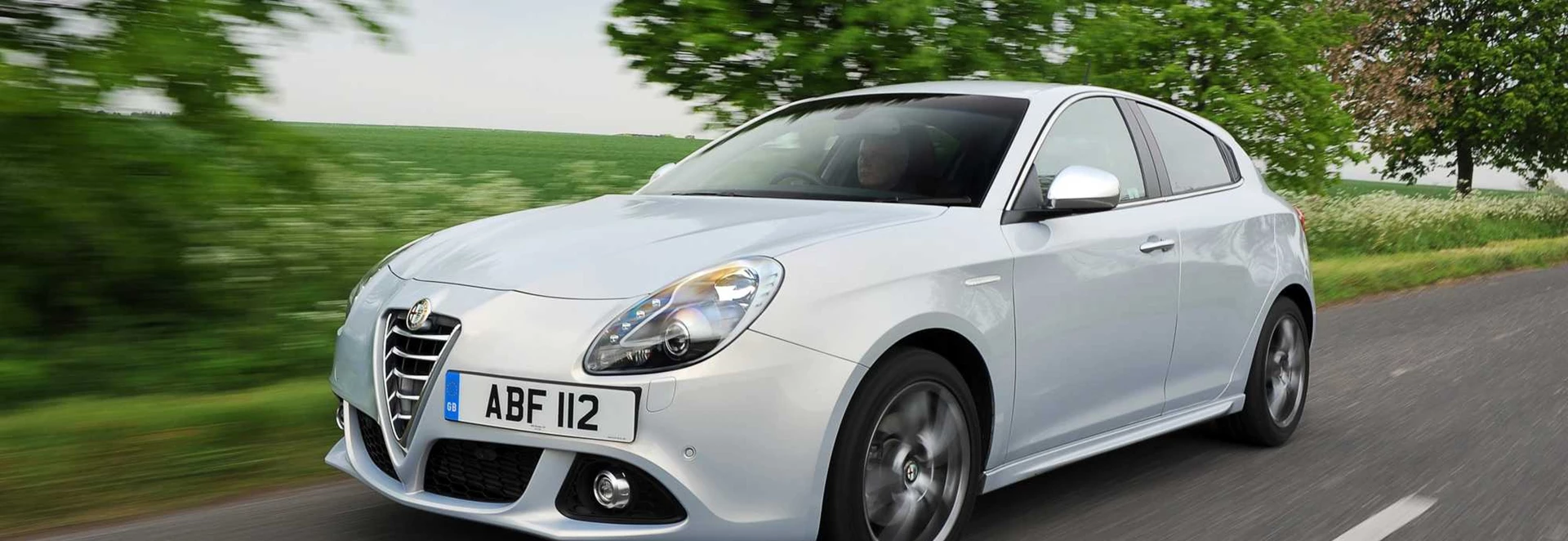When it arrived in 2010, the Giulietta stunned us with its characterful styling. It might be based on the underpinnings of the Fiat Bravo, but you certainly wouldn’t know it to look at. A small facelift in 2013 barely needed to alter the classy exterior, but the infotainment system was updated and the engine line-up was changed.
In 2014 a Quadrifoglio Verde (formerly called Cloverleaf) hot hatch was launched with the same 1.75-litre engine and TCT dual-clutch gearbox fitted in the Alfa Romeo 4C sports car.
Performance
The Giulietta is available with a 1.4-litre turbocharged petrol with power from 120 to 170bhp, a 1.6-litre diesel with 105bhp and a 2.0-litre diesel with 150 or 175bhp. If you want a petrol, the sweet spot in the range is arguably the 1.4-litre TB MultiAir with 150bhp, because it can get from 0-62mph in 7.6 seconds with respectable economy and a six-speed manual gearbox. We prefer the manual to the TCT dual-clutch automatic, which feels rather jerky, particularly when it’s cold.
Hot hatch fans will want the 1.75-litre Quadrifoglio Verde version with 240bhp and acceleration from 0-62mph in 6.0 seconds, which is quick for a front-wheel drive car. This shaves 0.8 seconds off the performance of the previous Giulietta Cloverleaf, because of a faster new gearbox equipped with a launch control system to help get it off the line. There’s no doubting the QV is fast – with a throaty induction roar – but the Golf R and Audi S3 both offer four-wheel drive, making them more usable in poor weather conditions.
Ride and Handling
Every version has firm suspension in keeping with Alfa’s sporting reputation, but models fitted with smaller alloy wheels are adept at soaking up bumps and prove comfortable to drive.
All Giulietta’s come with Alfa’s DNA selector, allowing the driver to switch between ‘Dynamic’, ‘Natural’ and ‘All-weather’ driving modes, the first of which sharpens throttle response and makes the steering heavier. The transformation is particularly noticeable in cars with the TCT gearbox, as it also speeds up gearshifts and allows higher revs in automatic mode. Every version has firm suspension in keeping with Alfa’s sporting reputation, but models fitted with smaller alloy wheels are adept at soaking up bumps and prove comfortable to drive. Giuliettas fitted with larger wheels can thump into potholes, but still offer decent comfort on smoother roads and motorways. The QV version is fitted with a Q2 electronic differential which helps reduce understeer and improves traction in tight corners. Unlike the aggressive Renaultsport Megane, we found the QV best-suited to a brisk but sensible driving style, making it something of a Grand Tourer, rather than a boisterous hot hatch.
Interior and Equipment
Alfa Romeo introduced the name ‘Giulietta’ in 1954, with a beautiful two-door coupe called the Giulietta Sprint, followed by a saloon Giulietta Berlina and then a convertible Giulietta Spider.
With plenty of character and a solid feel, the Giulietta’s cabin has more flair than most of its rivals. We particularly like the dashboard design, with a large touch-screen (in models fitted with the UConnect infotainment system) and three rotary controls for the climate control system. Saying that, some of the plastics for the lower console feel rather hard and cheap. The seats are attractively trimmed (particularly in the QV model), comfortable and supportive, but there’s not much kneeroom for rear passengers. At least they can get in easily, thanks to the Giulietta coming with five doors as standard. Its boot holds a decent 350 litres of luggage, but like the MiTo, a tall boot lip can make loading heavy items a chore.
Cost
Choose wisely and the Giulietta can be very economical, with the 1.6-litre diesel returning 70.6mpg and emitting 104g/km of CO2
Choose wisely and the Giulietta can be very economical, with the 1.6-litre diesel returning 70.6mpg and emitting 104g/km of CO2, costing just £20 in annual road tax. It’s not class-leading though, with the Golf, A3 and 1 Series line-ups offering at least one engine under the 100g/km barrier. The Giulietta QV has a respectable claimed economy of 40.4mpg, slightly less than the 44mpg of the Golf GTI Performance Pack and on a par with the four-wheel drive Golf R. The Renaultsport Megane 265 is thirstier, returning 37.7mpg.
Our Verdict
The Alfa Romeo Giulietta certainly looks more glamorous than many of its rivals, and boasts an attractive cabin. We also found Alfa’s UConnect infotainment system easy to use and there should be an engine to suit your needs. On the downsides, rear legroom is tight and we’d rather use a manual gearbox than the TCT dual-clutch automatic. Still, if you want to stand out from the crowd, the Giulietta could be just the car for you. It’s also reassuring to know the Giuletta has impressive safety credentials and hasn’t suffered the same reliability issues which damaged Alfa’s reputation in the past.




